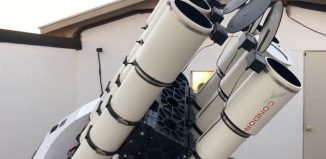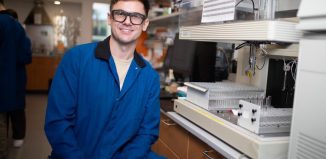Physicist wins German research prize
Dmitri Kharzeev’s work is hot. Indeed, the liquids he deals with are 100,000 times hotter than the interior of the sun.
Interested in the fundamental properties of matter, Kharzeev, a professor in the Department of Physics and Astronomy at Stony Brook and a senior scientist at Brookhaven National Laboratory, works at the Relativistic Heavy Ion Collider at BNL. There, he studies the so-called quark-gluon plasma. This primordial mixture is the most likely original soup from which life emerged in the moments after the Big Bang.
While Kharzeev looks closely at quarks, he has seen ways to apply his knowledge of chiral particles to an arena where heat can and is a problem: electronics.
When people put laptops on their laps, they can often feel the temperature of their microprocessors rising, making their laptops uncomfortably warm. The reason for this is that the transfer and processing of information in microprocessors generates heat, but the currents dissipate heat.
As it turns out, there are circumstances when the currents carried by chiral particles, like quarks, flow without any dissipation of heat. That is possible in the quark-gluon particles and in chiral materials, he explained.
Chirality is a state of handedness, in which a particle is not symmetrical. Kharzeev describes it as akin to a screw people can drive into a wall by turning its teeth either clockwise or counterclockwise to barrel through a substance.
“Chirality is the projection of angular momentum of a particle into its direction of motion,” he said.
When a quark approaches an impurity, it has to penetrate that barrier to conserve its chirality.
“When a chiral particle approaches a potential barrier, it penetrates it with 100% probability,” he said. “This is really a striking quantum phenomenon.”
Even further, the spin of a chiral particle is its nature, which means that it always moves and rotates. There is no rest state for it, the same way there is no rest state for light, he said.
“If, somehow, we were able to create chiral particles, not only in RHIC, but also in the materials around us, we could construct the next generation of electronic devices and we could solve a very big problem that mankind is facing,” Kharzeev said.
That problem is that the growth of the population of microprocessors, which consume energy, is faster than the growth in the human population.
That’s where graphene and substances like it enter the picture. Made of carbon atoms, the same way graphite and diamond are, graphene has electrons that behave as if they were chiral particles.
Kharzeev is a theoretical physicist. He is actively participating on the theory of chiral currents and that theory, he said, is being applied in chiral materials.
With the invention of graphene, “there is a gold rush,” he explained. “What is interesting for people like me is that the fundamental science and the applications are coming close together. People studying quarks could make research which could have an almost immediate practice application. This is very exciting and gratifying.”
Kharzeev said he got interested in graphene shortly after it was synthesized in the lab. Indeed, graphene has such potential that Andre Geim and Konstantin Novoselov at the University of Manchester received the Nobel Prize in Physics in 2010 for their groundbreaking work on it.
After reading one of their popular papers, Kharzeev realized “that, in many respects, graphene is similar to the quark-gluon plasma.”
Kharzeev recently received the Humboldt Research Award. The $80,000 award, which will allow him to work with German researchers at Goethe University in Frankfurt, among other places, is issued in Germany for scientific excellence.
“I am absolutely honored to receive this prize,” he said. “This is recognition of the work that we’ve been doing at Stony Brook and BNL for the past few years and I’m very excited for the new opportunities this prize offers.”
Jacobus Verbaarschot, a Stony Brook professor in the same department as Kharzeev who won the Humboldt Award in 2007, said he believes Kharzeev “deserves” the award, which is “good for the department.”
A resident of Port Jefferson, Kharzeev lives with his wife, Irina Sourikova, who is the database administrator of the PHENIX experiment at BNL.
Their older daughter, Maria, is an ICU nurse at the Memorial Hermann Hospital in Houston and plans to continue her education in an anesthesia school. Their younger daughter, Julia, is a student at Port Jefferson High School.
As for his research, Kharzeev is excited about the potential to contribute in a practical way to a significant challenge.
“The dissipation of heat now is the really major obstacle for electronics,” he said.






